Innovative Tools and Methods Using BIM for an Efficient Renovation in Buildings
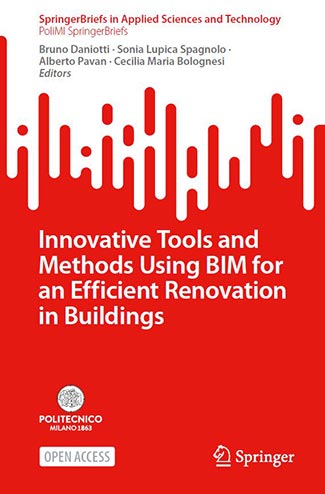
This open access book describes a BIM-based toolkit that has been developed according to the latest research activities on building information modelling and semantic interoperability to optimize the building process. It highlights the impacts of using such new tools to fast renovation activities starting from the decision-making and design stages to the construction site management with the possibility to monitor occupants' and owners’ feedback during the realization process. In this process, a framework has been developed and implemented to allow stakeholders involved in a renovation project to efficiently compile, maintain, and add data about (i) building elements, (ii) building services systems, (iii) tenants, operators, and owners of the building, and (iv) current and predicted performance of the building from the various data sources available. The framework applies and specializes the existing practices in the Semantic Web, Linked Data, and ontology domain to the management of renovation projects. It has been designed to be open so that any system which implements the required functions and uses the specified conventions will be able to achieve semantic interoperability with other framework-compliant systems in the renovation domain. Finally, this book represents the validation process of the toolkit that has been held in three demo sites: a social housing building in Italy and two private residential buildings in Poland and Finland. The outcome shows that the toolkit facilitates the renovation process with relevant reductions of time, costs, and energy consumption and that the inhabitants can take advantage of the increase in building performances, quality, and comfort.
Download PDF
The BIM Management System: A Common Data Environment Using Linked Data to Support the Efficient Renovation in Buildings
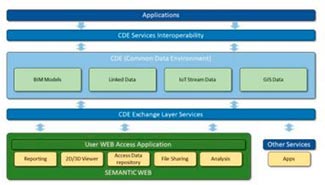
One of the main challenges of the construction industry is the management of the huge amount of data generated by the stakeholders during the whole lifecycle of the buildings. Data needs to be found, collected, shared, and updated minimizing the process and technological inefficiencies. Recent advances have been seen in the adoption of BIM-based approaches and in the implementation of CDE as an agreed source of information. This paper describes the development of the BIM management system as a platform to manage the building lifecycle data using the linked data paradigm to improve the interoperability and the interdisciplinary collaboration
Download PDF
The Development of a BIM-Based Interoperable Toolkit for Efficient Renovation in Buildings: From BIM to Digital Twin

Nowadays, buildings renovation is a subject of special interest since the building and construction sector is the main body responsible for energy consumption and emissions. Hence, it is necessary to concentrate on refurbishment to achieve Europe’s climate neutrality by 2050 according to European Agenda goals. The BIM4EEB Project, a BIM-based fast toolkit for the efficient renovation of residential buildings, directs the attention toward developing an exhaustive toolkit based on Building Information Modeling (BIM) to be adopted in the renovation of existing residential buildings, to make the flow of information efficient, decreasing intervention working time while improving building performances, quality, and comfort for inhabitants. BIM4EEB is developing a BIM management system connected to an operational and multifunctional toolkit for various architecture, engineering, and construction (AEC) stakeholders, integrating a set of tools for improving BIM adoption in renovation environments based on an interoperable flow of information. This paper presents the Horizon2020 Project and the framework used to develop the toolkit. In addition, the first outcomes of the toolkit development are outlined. The validation procedure in real environments has started to demonstrate the efficacy and applicability of the methodology and tools. Although the project is still in progress, benefits connected to the framework and the BIM-based toolkit result in an enhanced building renovation process.
Download PDF
Check and Validation of Building Information Models in Detailed Design Phase: A Check Flow to Pave the Way for BIM Based Renovation and Construction Processes-
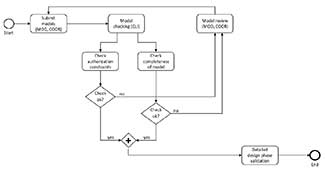
Model checking of building information models is gaining interest for academic and industrial fields. However, several limitations can be identified in the practical application of model checking processes. One of the main limitations is the unavailability of detailed guidelines describing how these checks should be developed. The research presented in this paper focuses on the development of a check flow that can be applied to any type of building project answering to three main questions, namely what to check, when to perform the check, and who should perform the check. During the research a complete guide for checking activity has been developed identifying the subjects responsible for each specific check during the process.
Download PDF
Ontological approach for LOD-sensitive BIM-data management ldac 2021
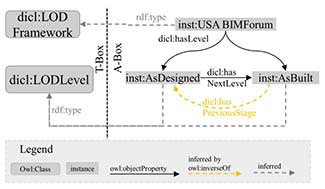
Since the last decade, LOD is a promising approach for efficient representation of semantically rich BIM data in different levels. Despite the improvement, there is a lack of effi-cient implementation in building lifecycle functionalities, because of their fun-damental heterogeneity, versatility and adaptability. The proposed approach en-ables the representation of LOD-sensitive BIM data through the formal defini-tion of ontologies. The paper validates this approach based on the concept of competency questions and their respective SPARQL queries. With the demon-stration and validation, the paper provides the conceptual proof for the practical application of the developed approach. The proposed solution can also be easily adaptable and applicable to the present BIM process since the representation of BIM data in different ontologies (BOT, ifcOWL, etc.) are within reach.
An explanatory use case for the implementation of Information Container for linked Document Delivery in Common Data Environments-An explanatory use case for the implementation of Information Container for linked Document Delivery in CDE EG-ICE 2021
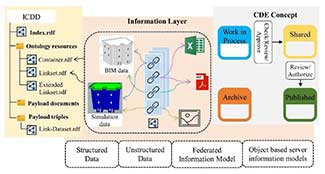
The BIM process is highly focused on the enrichment and management of domain data and its interoperability between fields. Many developments were proposed for data integration and sharing in terms of common data environments (CDE), multi-model approach, and open data standards (IFC, IDM), etc. However, often the information in BIM models is still managed in other proprietary formats. In April 2020 ISO 21597 (Information Container for Linked Document Delivery - ICDD) was introduced to enhance the semantic connection of heterogeneous data and document structures in the Architecture, Engineering, Construction and Operation domain (AECO) where the usage of different data formats is still of great diversity. Within this paper, we analyse ICDD capabilities, propose a standardised workflow for ICDD deployment and present a use case demonstrating these abilities of ICDD. Finally, an evaluation of the developed workflow is carried out based on Competency Questions and related SPARQL query profiles.
Download PDF
An Interoperable BIM-Based Toolkit for Efficient Renovation in Buildings
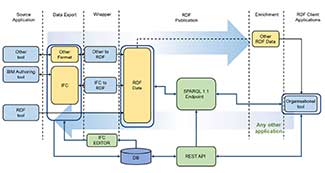
Since the buildings and construction sector is one of the main areas responsible for energy consumption and emissions, focusing on their refurbishment and promoting actions in this direction will be helpful to achieve an EU Agenda objective of making Europe climate-neutral by 2050. One step towards the renovation action is the exploitation of digital tools into a BIM framework. The scope of the research contained in this paper is to improve the management of information throughout the different stages of the renovation process, allowing an interoperable exchange of data among the involved stakeholders.
Download PDF
Building Renovation Process Map in Private and Public Works to Improve Communication and Data Exchange ICAMC 2020
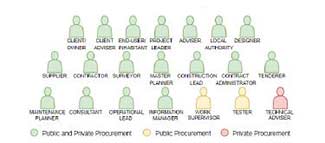
Along the building process the cooperation among several stakeholders and the integration of information during the whole project life cycle, whether it is a new project or a renovation intervention, are two key essential factors. In fact, in AEC sector the loss of information, the lack of data and the improper or repetitive exchange of information are common issues that may cause delays and cost increase. To enhance communication and data transfer, an appropriate rationalization of information flows is necessary. Starting from the outcomes of BIM4EEB, an ongoing Horizon2020 project, the paper analyses the workflow processes to understand how to optimise information workflows among different actors and along different stages by the use of ICT and BIM-based tools. Particular attention was payed to individualise the differences between public and private works in order to provide methods and apply the BIM4EEB approach to renovation process in both cases.
Download PDF
ANALYSIS ON AUTOMATIC GENERATION OF BEPS MODELS FROM BIM MODEL BauSIM2020
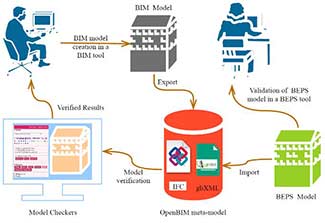
The interlinking of enriched BIM data to Building Energy Performance Simulation (BEPS) models facilitates the data flow throughout the building life cycle. This seamless data transfer from BIM to BEPS models increases design efficiency. To investigate the interoperability between these models, this paper analyses different data transfer methodologies along with input data requirements for the simulation process. Based on the analysed knowledge, a methodology is adopted and demonstrated to identify the quality of the data transfer process. Furthermore, discussions are provided on identified efficiency gaps and future work.
Download PDF
Enhancement of BIM Data Representation in Product-Process Modelling for Building Renovation. PLM 2020

Building Information Modelling (BIM) has the potential to become a technology which will help to use a holistic information repository to generate and represent relevant information in different building life-cycle stages (BLCS) to dedicated groups of stakeholders. However, the scope of model components of BIM data (e.g., IFC meta-data) is limited and some parts of it are not modelled in a manner that supports the diversity of engineering use cases. This paper aims to address this deficit by identifying the capability to formulate inference rules as one of the major benefits in the ontology-based information modelling approach. However, before one can formulate inferencing rules a detailed and in-depth understanding is required on how stakeholder information needs are defined in different BLCS and on how available, open-BIM meta-data models support these information requirements.
Download PDF
A Semantic Data Model to Represent Building Material Data in AEC Collaborative Workflows- PRO-VE 2020
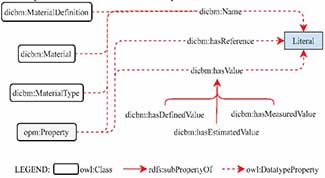
Building material information plays a vital role in design decisions by enabling different simulation processes, such as energy, acoustic, lighting, etc. Utilization and sharing of building material information between stakeholders are some of the major influencing factors on the practical implementation of the BIM process.However, these schemas have their own constraints to enable efficient data sharing amongst stakeholders. This paper explains these constraints and proposes a methodological approach for the representation of material data using semantic web concepts aiming to support the sharing of BIM data and interoperability enhancements in collaboration workflows. As a result, the DICBM ontology was developed which improves the management of building material information in the BIM-based collaboration process.
Download PDF
AN APPROACH FOR STANDARDIZATION OF SEMANTIC MODELS FOR BUILDING RENOVATION PROCESSES ISPRS 2020
.jpg)
The design and maintenance of buildings and infrastructures relies on digital tools such as Computer-Aided Design (CAD), Building Information Modelling (BIM) methods, Geographic Information System (GIS) datasets and other kinds of digital representation of knowledge. The innovations in digital technologies in Architecture, Engineering, Construction and Operations (AECO) sector are not just related to the enhancement of consolidated processes, but they open new collaboration methods and integration with other Information and Communication Technologies (ICT) such as Internet of Things (IoT), additive manufacturing, automation, augmented reality and artificial intelligence. A standardization and harmonization perspective for ontologies in the AECO industry, starting from the results achieved in the BIM4EEB project.
Download PDF
Building Renovation Process Map in Private and Public Works to Improve Communication and Data Exchange ICAMC 2020
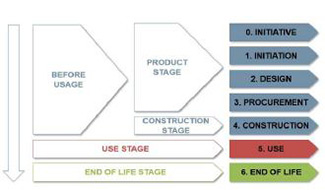
Along the building process the cooperation among several stakeholders and the integration of information during the whole project life cycle, whether it is a new project or a renovation intervention, are two key essential factors. In fact, in AEC sector the loss of information, the lack of data and the improper or repetitive exchange of information are common issues that may cause delays and cost increase.
Download PDF
A Digital Logbook as an Interactive Tool to Fulfil Service Companies’ Needs and Requirements in Building Renovations ICAM 2020
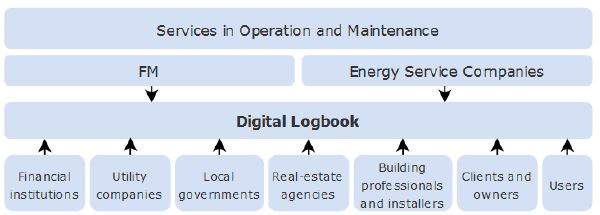
The lack of an appropriate information management along the life cycle of a construction work is one of the major issues that AEC sector is facing. The collection and exchange of information is already complex for new buildings, but it becomes even more difficult for renovations. Thus, the building logbook could have an essential role in improving the availability and quality of data for several stakeholders involved in the building process.
Download PDF
BIMcpd: A Combined Toolkit for Constraint Checking, Performance Evaluation and Data Management in Building Renovation Projects PROCEEDINGS MDPI 2020
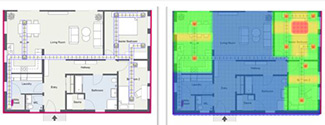
BIMcpd: A Combined Toolkit for Constraint Checking, Performance Evaluation and Data Management in Building Renovation Projects
Download PDF
Early Stage Energy Refurbishment Assessment Tool for Buildings Using High-End BIM Data: Benefits and Challenges. PROCEEDINGS MDPI 2020
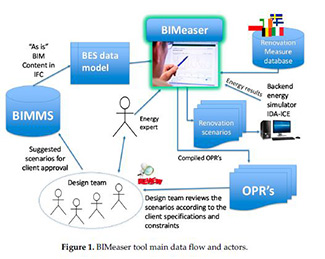
t is important to assess the effectiveness of different energy refurbishment scenarios in the early design stages of apartment buildings. This paper demonstrates the main features of a new tool BIMeaser (BIM Early Stage Energy Scenario - a product of the European Union Horizon 2020 project BIM4EEB), which supports the decision-making process in the early stage of design. The tool uses the BIM and linked data from the BIM Management System (BIMMS) for faster initialisation of the actual state, resulting in more accurate building models.
Download PDF
The BIM Management System: A Common Data Environment Using Linked Data to Support the Efficient Renovation in Buildings.PROCEEDINGS MDPI 2020

One of the main challenges of the construction industry is the management of the huge amount of data generated by the stakeholders during the whole lifecycle of the buildings. Data needs to be found, collected, shared, and updated minimizing the process and technological inefficiencies. Recent advances have been seen in the adoption of BIM-based approaches and in the implementation of CDE as an agreed source of information.
Download PDF
Workshop: BIM4EEB: A BIM-Based Toolkit for Efficient rEnovation in Buildings
.jpg)
On October 29th the workshop corresponding to the mid-term conference of BIM4EEB (Acronym of BIM Based Toolkit for Efficient rEnovation in Buildings, Horizon Project under grant agreement N. 820660 ) project was held during the Sustainable Places 2020 event. The main focus of the workshop was a general introduction of the project combined with vertical insights on the single tools that have been developed or are still in development. BIM4EEB grows from simple consideration: according to a BPIE analysis on EPC data, about 97% of building stock, currently not in A level, must be upgraded to achieve 2030 decarbonization objectives.
Download PDFSee more
Towards BIM-Enhanced Renovation Management Tools with Support to Stakeholder Interaction . Proceedings MDPI 2020
.jpg)
This paper presents two renovation management tools that are currently being developed in BIM4EEB project: BIMPlanner—a planning and management tool for housing renovation projects —and BIM4Occupants—a coordination tool between contractors and occupants.
Download PDF
FIP International Conference on Product Lifecycle Management
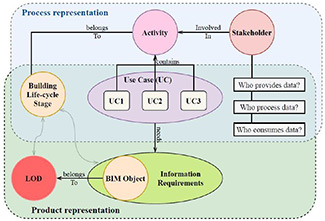
Building Information Modelling (BIM) has the potential to become a technology which will help to use a holistic information repository to generate and represent relevant information in different building life-cycle stages (BLCS) to dedicated groups of stakeholders. However, the scope of model components of BIM data (e.g., IFC meta-data) is limited and some parts of it are not modelled in a manner that supports the diversity of engineering use cases.
Download PDF
Boosting Collaborative Networks 4.0.November 2020
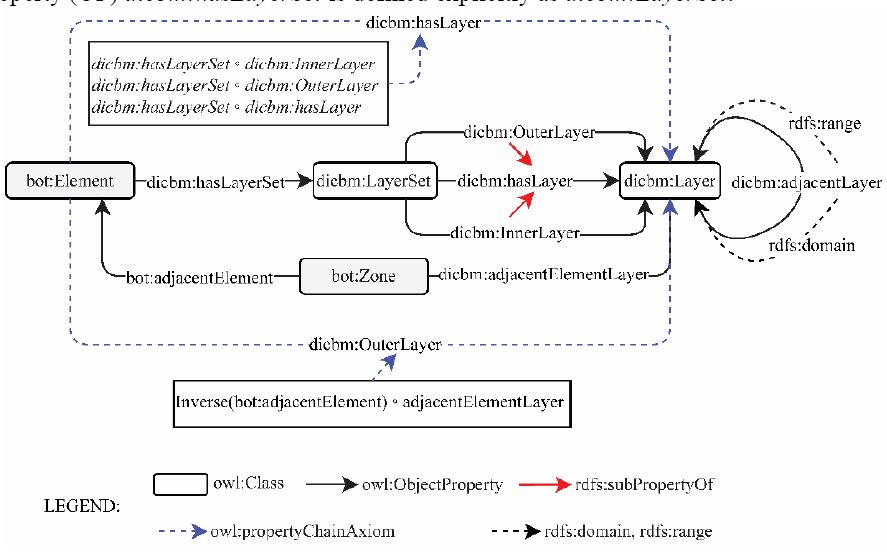
The specification of building material is required in multiple phases of engineering and construction projects towards holistic BIM implementations.Building material information plays a vital role in design decisions by enabling different simulation processes, such as energy, acoustic, lighting, etc.
Download PDF
The International Archives, August 2020
.jpg)
The innovations in digital technologies in Architecture, Engineering, Construction and Operations (AECO) sector are not just related to the enhancement of consolidated processes, but they open new collaboration methods and integration with other Information and Communication Technologies (ICT).
Download PDF
BUILD UP MAY 2020
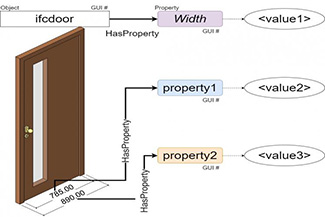
Interoperability in the construction sector is a key issue and researchers, developers and designers have tackled since the introduction of CAD systems. Traditionally, engineers, architects and site operators interact and track their information exchange through paper or digitalized drawings and e-mails. With the introduction of Building Information Modelling (BIM) techniques and tools, operators are using new solutions and methods to keep track and exploit these data.
See more
BUILD UP JUNE 2020
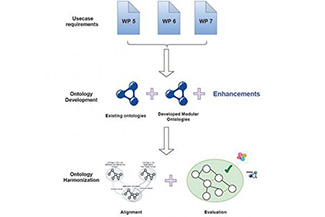
Linked Data technologies have been developed in order to connect concepts in a structured way, enhancing machine readability and enabling many features like semantic queries. The potential of such technologies is wide in many fields, in particular in the construction sector, which could benefit in many ways by their application.
See more
CASA CLIMA 78
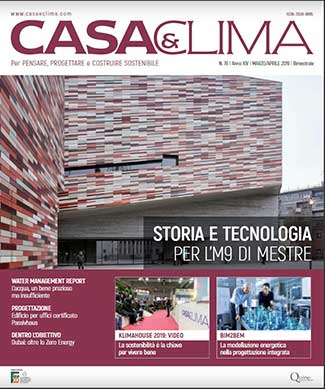
Download PDF
IERC WEBSITE NOV 2019

The School of Engineering at UCC and the International Energy Research Centre (IERC) at Tyndall welcome new research funding from the EU Horizon 2020 Programme via the Energy Efficiency Buildings (EeB) Public-Private Partnership (PPP).
See more
BUILD UP OCT 2019
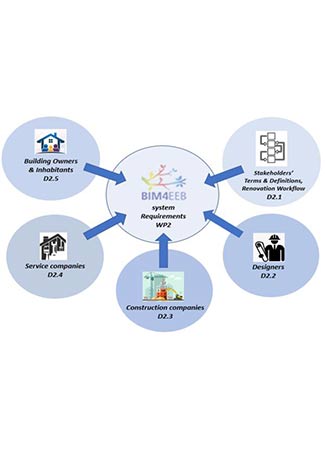
The digital transformation of the AEC sector is facing several criticalities which have to be solved in order to effectively exploit its different potentialities.
See more
Einb 2019: 8th international conferece-Scientific paper
.jpg)
We introduce an innovative BIM-based framework for efficient renovation in buildings comprising of tools supporting the AEC actors and building's stakeholders (owners and occupants)
Download PDF
BUILD UP Sept 2019
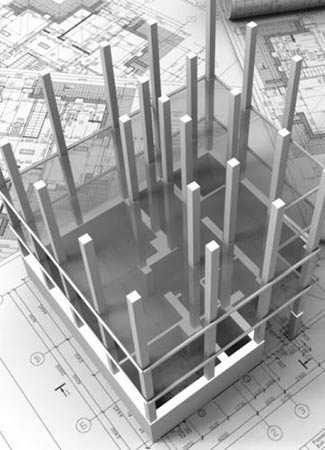
The project BIM4EEB will deliver an innovative common BIM management system with linked data and a toolkit; this is the basic instrument for increasing semantic interoperability between software and stakeholders involved.
See more

 BIM4EEB
BIM4EEB









.jpg)





.jpg)
.jpg)


.jpg)





.jpg)
